
Curtisia dentata is a flowering tree from Southern Africa. It is the sole species in genus Curtisia, which was originally classed as a type of "dogwood" (Cornaceae), but is now placed in its own unique family Curtisiaceae.
Ironwood is a common name for many woods or plants that have a reputation for hardness, or specifically a wood density that is heavier than water, although usage of the name ironwood in English may or may not indicate a tree that yields such heavy wood.
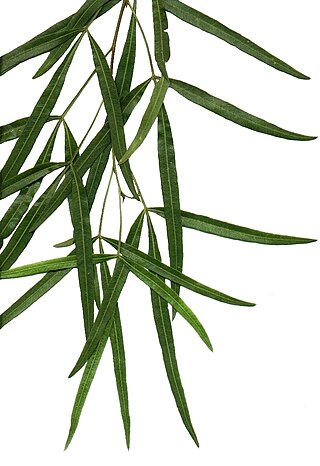
Searsia lancea commonly known as karee, is an evergreen, frost hardy, drought resistant tree, which can reach up to 8 metres in height with a 5-metre spread. It is one of the most common trees on the Highveld and in the Bushveld in South Africa, but not found in the Lowveld. In North America, where it is naturalized, it is known as African sumac and willow rhus.
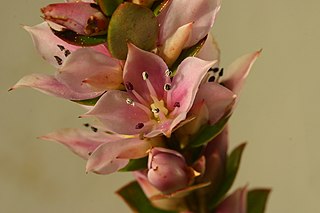
Geissoloma is a genus of flowering plants in the monotypic family Geissolomataceae, native to the Cape Province of South Africa. Geissoloma marginatum is the only species in the family. It is sometimes called guyalone in English. The plants are xerophytic evergreen shrubs and are known to accumulate aluminum.
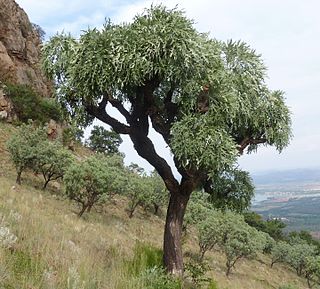
Cussonia paniculata, also known as kiepersol, is a large evergreen shrub or small tree up to 5 metres (16 ft) in height native to South Africa. The plant has large and bold textured grey foliage.

Widdringtonia wallichii, Clanwilliam cedar or Clanwilliam cypress, previously Widdringtonia cedarbergensis is a species of Widdringtonia native to South Africa, where it is endemic to the Cederberg Mountains northeast of Cape Town in Western Cape Province. It is threatened by habitat loss and protected in South Africa under the National Forest Act of 1998.
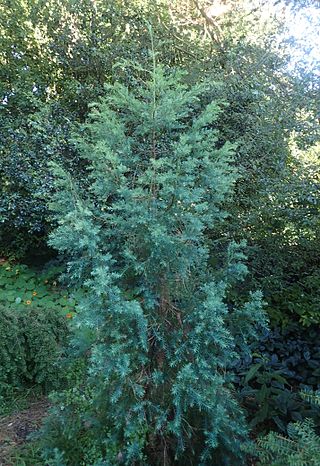
Widdringtonia schwarzii is a species of Widdringtonia native to South Africa, where it is endemic to the Baviaanskloof and Kouga Mountains west of Port Elizabeth in Eastern Cape Province; it occurs on dry rocky slopes and crags at 600-1,200 m altitude. It is threatened by habitat loss, particularly by wildfire. The Willowmore cypress is a protected tree in South Africa.

Vepris is a genus of plant in family Rutaceae. It comprises around 90 species, mainly from tropical Africa, Madagascar and the Mascarene Islands and at a lesser extent Arabia and India.
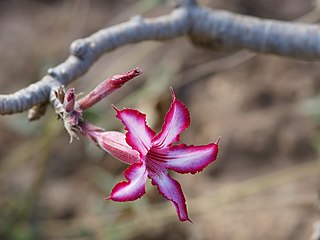
Adenium multiflorum is small, succulent tree native to central and eastern Southern Africa. It may be deciduous or evergreen, and is found in dry woods or grassland in its native habitat. It is typically 0.5-3 m tall. Like other succulent members of the family Apocynaceae, A. multiflorum has a milky latex with toxic alkaloids, specifically Cardiac glycosides. This latex is used as an arrow poison and as a fish stunning poison.
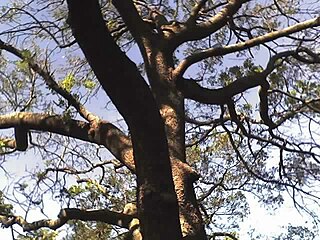
Ekebergia capensis is a tree in the family Meliaceae. It is commonly known as the Cape ash. Its range extends from the Eastern Cape of South Africa to Sudan and Ethiopia. It has been introduced onto Ascension Island.

Papilio constantinus, the Constantine's swallowtail, is a butterfly of the family Papilionidae. It is found in Sub-Saharan Africa.

Myrsine melanophloeos, commonly known as Cape beech, Kaapse boekenhout (Afrikaans), isiCalabi (Zulu) or isiQwane sehlati (Xhosa) is a dense evergreen tree that is native to the afromontane forests of Africa, ranging from Nigeria and Sudan to South Africa. Outside forests they are also commonly encountered along stream banks and in gullies.

Apodytes dimidiata is a bushy tree with white flowers bearing a fragrance reminiscent of fresh coconut, and small black and red fruits. It is usually about 5 m tall, and it is indigenous to Southern Africa. The taxonomical family placement for this and other Apodytes was uncertain; it is now placed in the Metteniusaceae. Its English common name is in reference to the timber which is similar in appearance to that of the European pear tree of the northern hemisphere.
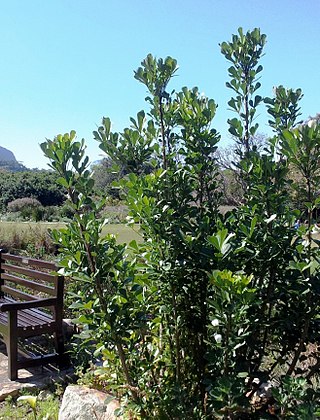
Cussonia thyrsiflora, known as the Cape coast cabbage tree, or Kaapse kuskiepersol in Afrikaans, is a small evergreen tree in the family Araliaceae.

Asparagus densiflorus, the asparagus fern, plume asparagus or foxtail fern, is a variable evergreen perennial plant, closely related to the vegetable asparagus.

Harpephyllum is a genus of trees in the family Anacardiaceae. The sole species is Harpephyllum caffrum, a dioecious evergreen species from South Africa and Mozambique that is also cultivated. The fruit is edible.

Englerophytum natalense, the silver-leaf milkplum, is a medium-sized, evergreen tree that occurs along forested escarpments from East Africa to South Africa. The leaves are alternately arranged or spiralled, and to some extent crowded near the ends of branches. They are glossy green to greyish green above and covered in silvery hairs below. The stem is straight and the bark smooth. Young branches are covered with dense brownish hairs. The plant contains a milky latex.
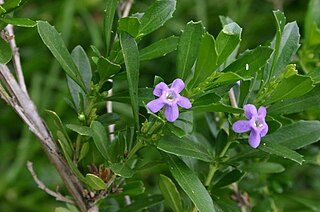
Freylinia is a genus of flowering plants in the figwort family Scrophulariaceae. They are native to Africa.
Vepris bremekampii, the wart-berry or wild mandarin, is a species of flowering plant in the family Rutaceae, native to southern Mozambique and northern South Africa. An evergreen shrub or small tree reaching 6 m (20 ft), its 1.4 cm (0.6 in) fruit are wrinkled and warty with a resemblance to Citrus.


















